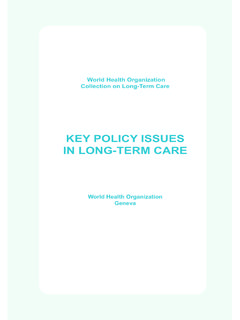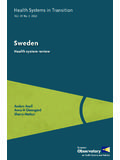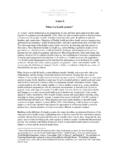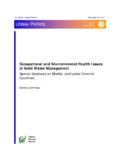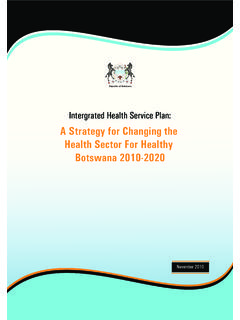Transcription of Health and health behaviour among young people
1 WORLDHEALTHORGANIZATIONEUROPE hbscUniversit tBielefeldamong young PeopleHealth and Health BehaviourWHO Policy Series: Health policy for children and adolescents Issue 1 INTERNATIONAL REPORTA ddress for correspondence: Health Promotion and Investment for HealthWorld Health organization Regional Office for Europe8 ScherfigsvejDK-2100 CopenhagenDenmarkEUR/ICP/IVST 06 03 05(A)UNICORN no. E67880 ENGLISH ONLY among young PeopleHealth and Health BehaviourEditors: Candace Currie, Klaus Hurrelmann,Wolfgang Settertobulte, Rebecca Smith, Joanna ToddHealth behaviour in School-aged Children:a WHO Cross-National Study (HBSC)International ReportABSTRACTThe series Health Policy for Children and Adolescents (HEPCA) is a WHO documentseries mainly based on results of the international survey Health behaviour inSchool-aged Children (HBSC) and on other relevant international studies. Itfocuses on the implications of scientific results for Health policy in developed coun-tries.
2 The target groups are politicians and experts, especially those concerned withthe Health of young people . The HEPCA series consists of reports on particular top-ics of high political relevance, including survey data on child and adolescent Health ,reports on specific Health situations and suggestions for future investment in healthpolicies for the young BEHAVIORHEALTH BEHAVIORHEALTH SURVEYSCHILD WELFARECROSS-CULTURAL COMPARISONSCHOOLSFAMILY RELATIONSPEER GROUPSOCIOECONOMIC FACTORSEUROPEEASTERN EUROPERUSSIAN FEDERATIONUNITED STATESCANADAH ealth Policy for Children and Adolescents (HEPCA) Series No. 1 world Health organization 2000 All rights in this document are reserved by the WHO Regional Office for Europe. The document may nevertheless be freely reviewed, abstracted,reproduced or translated into any other language (but not for sale or for use in conjunction with commercial purposes) provided that fullacknowledgement is given to the source.
3 For the use of the WHO emblem, permission must be sought from the WHO Regional Office. Any trans-lation should include the words: The translator of this document is responsible for the accuracy of the translation. The Regional Office wouldappreciate receiving three copies of any translation. Any views expressed by named authors are solely the responsibility of those TARGET4 Health OFYOUNGPEOPLEBy the year 2020, young people in the Region should be healthier and better able to fulfil theirroles in society(Adopted by the WHO Regional Committee for Europe at its forty-eighth session, Copenhagen, September 1998)EUROPEANHEALTH21 TARGET13 SETTINGSFORHEALTHBy the year 2015, people in the Region should have greater opportunities to live in healthyphysical and social environments at home, at school, at the workplace and in the local community(Adopted by the WHO Regional Committee for Europe at its forty-eighth session, Copenhagen, September 1998) The international HBSC Study: rationale, history and description Candace Methods Chris Roberts, Yves Fran ois, Joan Batista-Foguet & Alan collection and file analysis and of the Adolescents general Health and wellbeing Peter Scheidt, Mary D.
4 Overpeck,Wendy Wyatt & Anna Health and Family and peer relations Wolfgang shape of within The school environment and the Health of adolescents Oddrun Samdal & Wolfgang D with Socioeconomic inequalities in adolescent Health Elaine Mullan & Candace young people s socioeconomic and Exercise and leisure-time activities Mary Hickman, Chris Roberts & Margarida Gaspar de Eating habits, dental care and dieting Carine Vereecken & Lea and crisps and fried and and full-fat of socioeconomic position of Substance use Saoirse Nic Gabhainn & Yves Fran Sexual behaviour James Ross & Wendy of sexual of Country children, as a defined population group, have until recently been neglected by na-tional and international public Health researchers. This can partly be explained by the guidanceprovided by morbidity and mortality data, which consistently placed school-aged children atthe low end of the risk cycle, and the lack of strong global political constituency advocatingtheir Health needs.
5 A dramatically broadened definition of morbidity and the rapid growth ofyouth advocacy groups and programmes such as the Health promoting schools project of theWHO Regional Office for Europe have combined to create a more friendly environment foryouth research, Health promotion processes programmes and ultimately policies sensitive toyoung people . Over the years the Health behaviour in School-aged Children Study has playedan increasing key role in moving the youth Health agenda in a direction that provides evidenceneeded for both credible and effective governmental decisions affecting young people andinformed social has been a lot of talk about evidence-based public Health . The HBSC Study is a primeexample of its potential to redefine international goals, methods and outcome measures. Fur-ther, its continuous nature ensures the timeliness of its findings. Its cross-national natureprovides the added opportunity to account for differences affected by broader realities ofmacroeconomic, cultural, and political variants.
6 The HBSC Study offers what may be a uniqueexample of how psychosocial observations interact with structural variables to produce a morereasoned, more balanced approach to Health development. After all, as far as improving thehealth of school-aged children, intervention options can now begin to be seen as interactive,rather than competitive. With the results of the HBSC Study, stakeholders in young people shealth, particularly young people themselves, can now map out where and how behaviourchange meshes with policy development; where the psychosocial domain connects with theeconomic and policy domains. How can the HBSC Study be most useful at the ground level? What should communities makeof the data immediately and in the medium term? We predict that the HBSC Study will becomea centrepiece for discussion and, yes, controversy. The data raise alternatives for action withdifferences in costs as well as benefits.
7 It will be refreshing to debate options where heretoforethere were few or none to , the special contribution of the HBSC Study is its reliance on young people as a re-source, full partners in the definition of issues, the consideration of strategy, and the judgementof programme and policy benefits. This is radical departure from the tradition of top-down plan-ning and professional dominance of the public Health process, and the end of the hegemony ofsingle disciplinary approaches to research and evaluation. So far, each wave of data collectionhas incorporated fresh insights into factors and forces affecting the Health of the school-agedchild and, indeed, the new emphasis on youth as a Health promoting resource beyond diseaseor injury prevention. We have every expectation that this kind of responsiveness to changes inconcept, perspectives, and research technology will continue. Erio ZiglioVivian Barnekow RasmussenRegional AdviserTechnical AdviserHealth Promotion and Investment for HealthHealth Promotion and EducationWHO Regional Office for EuropeWHO Regional Office for EuropePreface5 The Health behaviour in School-Aged Children (HBSC) Study involves the collaboration ofresearchers from several countries, under the auspices of the world Health OrganizationRegional Office for Europe (WHO) and the team from Canada and the United States.
8 Com-prehensive surveys of 11, 13, and 15 year olds are carried out every four years in a growingnumber of countries and are used to investigate Health issues within and across participatingcountries. Erio Ziglio and Vivian Barnekow Rasmussen represented the WHO Regional Officeduring the planning and administration of the 1997-98 survey and ensured WHO standardswould be met in the preparation of this report. Professor Klaus Hurrelmann and Dr Wolfgang Settertobulte of Bielefeld University wereresponsible for preparing and co-ordinating this international report. Editing was carried out byWolfgang Settertobulte, Mary Stewart Burgher (WHO), Rebecca Smith, Joanna Todd andCandace Currie (University of Edinburgh). Publication procedures were efficiently dealt withby Bente Drachmann, Tina Ki r and Rainer Verhoeven (WHO).For the 1997-98 survey Candace Currie, University of Edinburgh, served as InternationalCoordinator and Bente Wold, University of Bergen, served as Data Bank Manager.
9 OddrunSamdal, University of Bergen, subsequently served as Data Bank Manager during the prepara-tion of this report. The enthusiastic and committed efforts of 30 teams of researchers from 29 countries in the plan-ning and administration of the surveys made this report possible. The data collection in eachcountry was funded at a national level. We are grateful for the financial support offered by thevarious governments ministries, research foundations and other funding bodies in the partici-pating countries. The following, listed by country, are the national team members who participated in the 1997/98survey. Full contact details can be found on the HBSC web site: Last, but not least, we are very grateful for the cooperation of all the students who were will-ing to share their experiences with us, and to their schools for making this survey Hurrelmann Wolfgang SettertobulteGreeceAnna Kokkevi Manina TerzidouGreenlandMichael PedersenMaria del CarmenGranado AlconHungaryAnna Aszmann gnes N methR ka Czegl di gnes GordosSandor RozsaIrelandSaoirse Nic Gabhainn IsraelYossi HarelMichal MolchoDina LacheGiora RahavPalestinian AuthorityMohamed AffifiZiad AbdeenLatviaIeva RankaIlze KalninsLithuaniaApolinaras ZaborskisLinas SumskasNida ZemaitieneAiste DirzyteNorthern IrelandGrace McguinnessNorwayOddrun SamdalBente WoldTorbj rn TorsheimSiren HauglandJ rn Hetland Heidi EilertsenPolandBarbara Woynarowska Joanna MazurPortugalMargarida Gaspar De Matos Celeste SimoesLucia CanmaRussian FederationAleksander KomkovScotlandCandace Currie Joanna ToddRebecca SmithSlovak RepublicMiro BronisPavol StraussSpainRam n Mendoza Joan Batista-FoguetSwedenUlla MarklundMia DanielsonSwitzerlandB atrice Janin Jacquat Yves FrancoisUnited StatesMary Overpeck Peter Scheidt Jim
10 RossWendy WyattWalesChris Tudor-Smith Chris Roberts Elaine MullanAustriaWolfgang D rAnselm EderBelgium (Flemish)Lea Maes Carine VereeckenBelgium (French)Danielle Piette Laurence KohnMichel Boutsen A. LevequePatrick De SmetCanadaAlan KingWendy K. Warren Will BoyceMatt KingMary JohnstonCzech RepublicLadislav Cs my Hana ProvaznikovaHana Sovinov Jaroslava RazovaDenmarkBj rn E HolsteinPernille DueIna BorupInge LissauMette RasmussenLis JensenEnglandMary Hickman Antony MorganEstoniaMai MaserKaili Kepler FinlandJorma Tynj l Lasse KannasRaili V lim aRiikka P ts nenFranceChristiane DressenEmmanuelle Godeau7 Research into children s Health and Health behaviour and the factors that influence them isessential for the development of effective Health education and Health promotion policy, pro-grammes and practice targeted at young people . It is important that young people s Health isconsidered in its broadest sense, as encompassing physical, social and emotional wellbeing; andthat, in accordance with the WHO perspective, Health is viewed as a resource for everyday liv-ing, not just the absence of disease.










